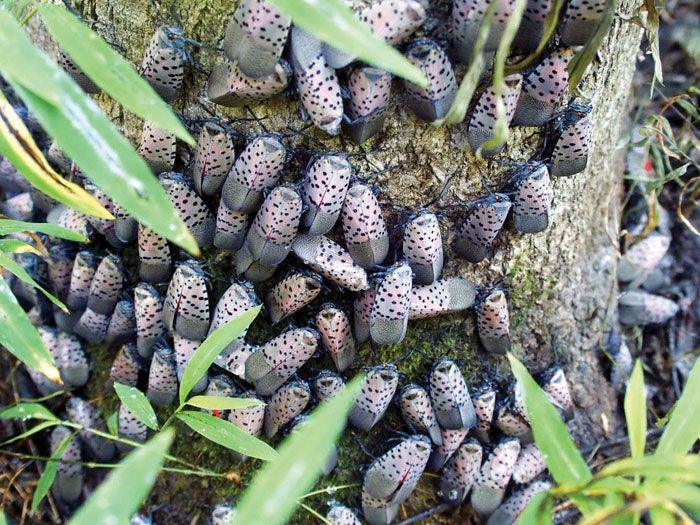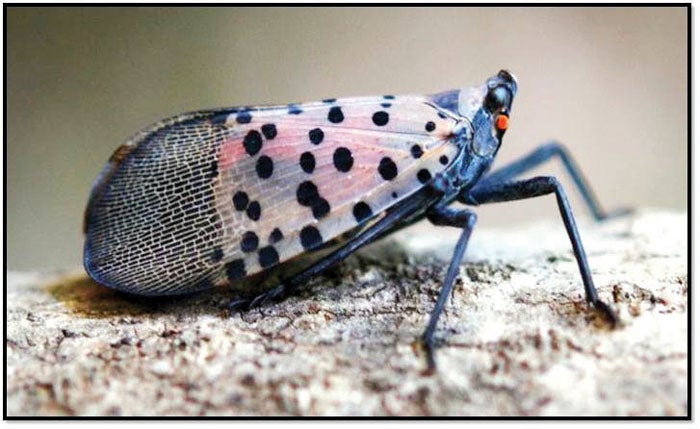Amy-Lynn Albertson: Look out for spotted lanternfly this summer
Published 12:00 am Saturday, May 27, 2023
By Amy-Lynn Albertson
The spotted lanternfly is an invasive planthopper first found in the U.S. in Berks County, Pennsylvania, in 2014. This insect is native to northern China and spread to Korea in 2004, becoming a significant pest. The adult spotted lanternfly is about 1 inch long and ½ inch wide. Their front wings are light gray with black spots, with wingtips patterned with lines of small black blocks. The back wings are red and black with a white band. Their bodies are yellow with black bands down the middle. Each egg mass, laid in a row, contains 30-50 eggs and is usually covered by a waxy substance.
Nymphs hatch from their egg cases from late April to early May. A nymph passes through several immature stages. In the first stage, it is wingless and looks black with white spots. It then grows red patches in addition to the white spots. Next, it has red wing pads and a red upper body. Nymphs cannot fly, so they hop or crawl to search for plants to feed upon. Young nymphs appear to have a more extensive host range early on, which narrows as they grow older. In the fall, adults mate and lay eggs from late September through the onset of winter. In their native habitat, they will lay their eggs preferably on the tree-of-heaven (Ailanthus altissima), which is also an introduced invasive tree species. The lanternfly will lay eggs upon any smooth-trunked tree, stone or vertical surface, including manufactured items like vehicles, campers, yard furniture, farm equipment or other items stored outside. The lanternfly’s life expectancy is one year.
Trees can develop weeping wounds of sap on their trunks. Heavy infestations can cause honeydew secretions to build up at the tree’s base, blackening the soil with fungal mats around the bottom of the tree. The sap may attract ants, bees, hornets and wasps to feed on it. The plant may be stunted or even die. In July 2018, a spotted lanternfly was confirmed in three New Jersey counties, and in September 2018, in two New York locations and Virginia. On Feb. 28, 2019, the Delaware Department of Agriculture signed Emergency Regulations for spotted lanternflies that enacted a quarantine for this pest.
North Carolina Department of Agriculture officials say initial surveys indicate the spotted lanternfly distribution is within a five-mile radius of where it was spotted in Forsyth County, from Interstate 40 near Kernersville to Guilford County. Heavy concentrations of the insects were found, signifying this was an established colony that had been there for several years. Spotted lanternfly poses a severe threat to our wine and grape industry and can damage more than 70 species of plants, including apples, roses and other landscape plants. The spotted lanternfly could decimate a vineyard in less than two years.
According to the Department of Agriculture statement, anyone visiting states with a lanternfly presence should thoroughly wash and inspect their vehicles and related equipment before returning to North Carolina. Officials also cautioned to “not move firewood.” The lanternfly doesn’t bite or sting humans, so it physically can’t be harmful. “If your summer travel plans include driving through Pennsylvania, Maryland, Virginia, Delaware or New Jersey … do your part to prevent bringing the pest to our state,” Agriculture Commissioner Steve Troxler said in a release. If you think you have seen spotted lanternfly, please take a photo (and try to include a size reference such as a quarter or pen). Go to www.ncagr.gov to find information on how to report you sighting or call the Rowan County Extension Center for help 704-216-8970.
When submitting a report please include the location of the sighting, the date and your contact information. If the insect got away, please take a picture of the location where you saw it.
Amy-Lynn Albertson is director of the Rowan County Extension.







